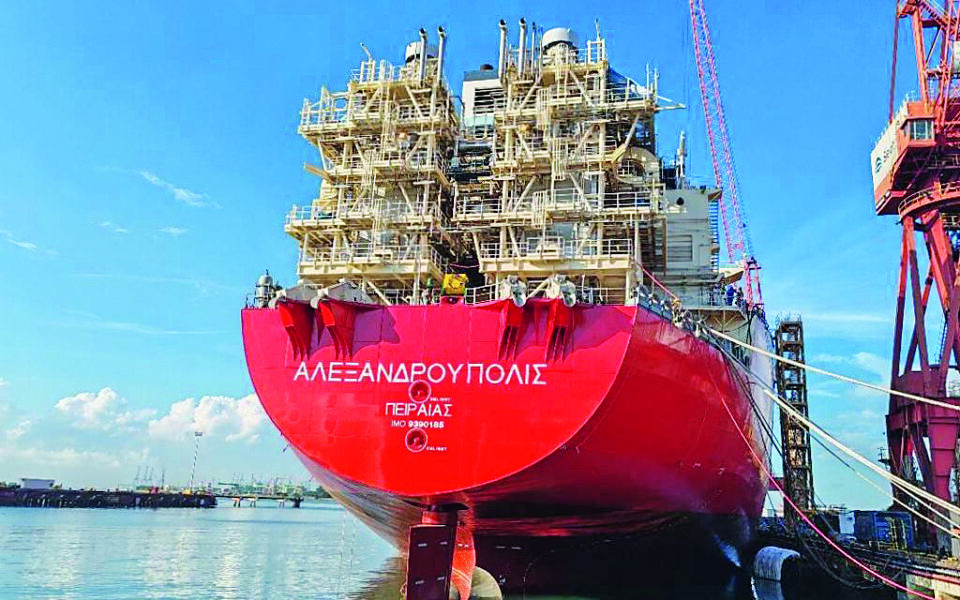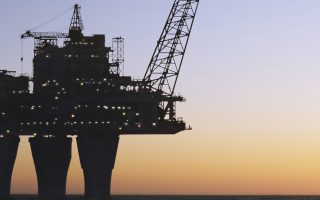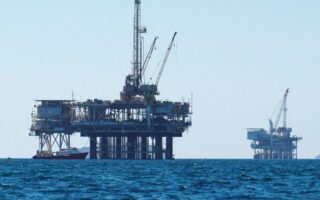Alexandroupolis FSRU sailing into port
Floating LNG terminal getting into position, ready to start work in first quarter of 2024

After undergoing a conversion into a floating storage regasification unit (FSRU), the GasLog tanker set sail on November 26 from Seatrium, Keppel’s famous shipyard in Singapore and where most conversations from LNG tanker to FSRUs are carried out, and is expected to reach the port of Alexandroupoli on December 17.
Named after the historic northern Greek city, the Alexandroupolis will assume its new position 17.6 kilometers southwest of the port and 10 kilometers from the nearest coast, as per the strict safety protocols of the Seveso Directive.
The FSRU’s arrival at its permanent anchorage marks the completion of a landmark project for both the country and the broader region. Once all the necessary tests are carried out, the unit is expected to become fully operational in the first quarter of the new year.
Launched by Dimitris Copelouzos in 2010, the endeavor has been fully vindicated by the geopolitical developments following Russia’s invasion of Ukraine and addresses the urgent need for Europe to reduce its dependence on Russian natural gas.
‘It will redefine the city’s position on the global map as a crucial hub for energy security across Southeastern Europe’
The operation of this new terminal will enhance Greece’s role as a gateway for the broader region of energy that is not reliant on Russia. It is a project with an indisputable regional scope, which aims at the markets of Southeastern Europe all the way to Ukraine, and also of Central Europe, all the way to Hungary and Slovakia, accounting for total natural gas consumption of 65 billion cubic meters annually (almost equal to Germany’s). Indeed, 80% of the terminal station’s capacity has already been secured on a long-term basis by 13 companies operating in the region, including Greek ones, while interest has also been expressed by others for the remaining capacity.
The Alexandroupolis LNG terminal is a sizable floating industrial unit with a storage capacity of 153,500 cubic meters and three liquefaction units. These units will operate either with a seawater circuit or by burning natural gas, with a maximum daily liquefaction capacity of approximately 22.5 million cubic meters and a maximum annual capacity of 5.5 billion cubic meters of gas. The floating station will be connected to the central natural gas pipeline in the area of Amphitriti, where the Hellenic Gas Transmission System Operator (DESFA) is constructing the metering station. This metering station is expected to start operating in the second half of January, initiating the trial operation of the unit, which will last for approximately six weeks. Commercial operation is expected to commence between February 20 and March 15.
The Alexandroupolis terminal will be connected to the national natural gas system through a pipeline that is 28 kilometers long, the large part of which (24 km) is submerged underwater. The subsea pipeline trenching has been completed, and the construction of the onshore section, currently at 98% completion, is expected to be finished by the end of this month.
It is estimated that 60-70% of the gas produced at the regasification unit will be exported through the Interconnector Greece-Bulgaria (IGB) pipeline and the Sidirokastro station in reverse flow to Bulgaria. Using the existing network of interconnected pipelines it will then reach Serbia, North Macedonia, Romania, Moldova and Ukraine, as well as Hungary and Slovakia to the west.
What is expected to play a crucial role in the project’s export orientation is the initiative for a vertical corridor connecting Greece with the aforementioned countries. The parties on the Greek side are DESFA and Gastrade, whose shareholders include Elmina Copelouzos, GasLog, the Public Gas Corporation (DEPA), Bulgartransgaz and DESFA, which is responsible for the implementation and operation of the Alexandroupolis FSRU. The cost of the investment is expected to come to around half a billion euros, some 50% of which will be covered by national and European resources.
As for what it means for the northern Greek port of Alexandroupoli, speaking to Kathimerini, the president and CEO of Gastrade, Konstantinos Sifnaios, described it as a “landmark project that will also bolster employment and the local economy with 120 new permanent jobs, but above all, it will redefine the city’s position on the global map as a crucial hub for energy security across Southeastern Europe.”
Moreover, added Sifnaios, “it will constitute an additional pillar of national security for the border region of Thrace, as it is an integrated part of the international and European strategy for diversification and independence of energy sources and transportation routes from historical monopolies.”
As for the country as a whole, the Alexandroupoli unit “is a major step in consolidating and elevating Greece’s role as a leading element of stability and guarantor of security in the broader, northward region,” Sifnaios said.





